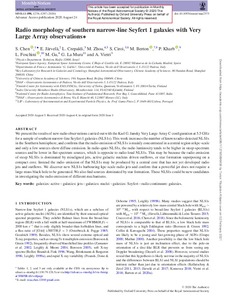Radio morphology of southern narrow-line Seyfert 1 galaxies with Very Large Array observations
S. Chen; E. Järvelä; L. Crepaldi; M. Zhou; S. Ciroi; M. Berton; P. Kharb; L. Foschini; M. Gu; G. La Mura; A. Vietri
Radio morphology of southern narrow-line Seyfert 1 galaxies with Very Large Array observations
S. Chen
E. Järvelä
L. Crepaldi
M. Zhou
S. Ciroi
M. Berton
P. Kharb
L. Foschini
M. Gu
G. La Mura
A. Vietri
Oxford University Press
Julkaisun pysyvä osoite on:
https://urn.fi/URN:NBN:fi-fe2021042821614
https://urn.fi/URN:NBN:fi-fe2021042821614
Tiivistelmä
We present the results of new radio observations carried out with the Karl G. Jansky Very Large Array C-configuration at 5.5 GHz for a sample of southern narrow-line Seyfert 1 galaxies (NLS1s). This work increases the number of known radio-detected NLS1s in the Southern hemisphere, and confirms that the radio emission of NLS1s is mainly concentrated in a central region at kpc-scale and only a few sources show diffuse emission. In radio-quiet NLS1s, the radio luminosity tends to be higher in steep-spectrum sources and be lower in flat-spectrum sources, which is opposite to radio-loud NLS1s. This may be because the radio emission of steep NLS1s is dominated by misaligned jets, active galactic nucleus driven outflows, or star formation superposing on a compact core. Instead the radio emission of flat NLS1s may be produced by a central core that has not yet developed radio jets and outflows. We discover new NLS1s harbouring kpc-scale radio jets and confirm that a powerful jet does not require a large-mass black hole to be generated. We also find sources dominated by star formation. These NLS1s could be new candidates in investigating the radio emission of different mechanisms....
Kokoelmat
- Rinnakkaistallenteet [27094]
